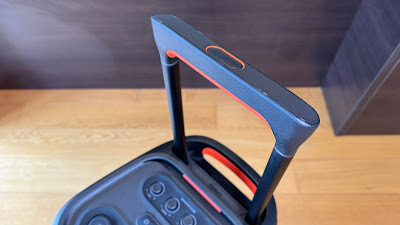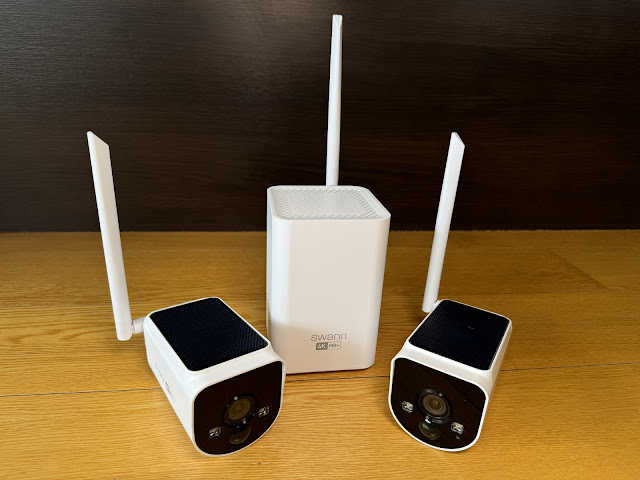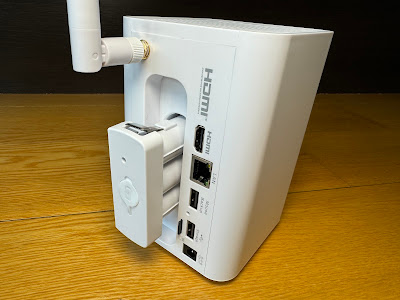In an incredibly crowded bluetooth speaker market, somehow JBL has managed to carve out quite a niche for itself when it comes to oversized party speakers with flashing lights and amazing bass performance.
The idea seems to be, whether you're dancing, singing or just need a few coloured lights and a room-filling sound, JBL has a single box that will do the job.
In fact, in recent years, JBL has come up with several options that'll do the job, each iteration getting brighter, bigger and louder.
The PartyBox Stage 320 isn't even the biggest party speaker in the JBL line-up; that honour goes to the PartyBox Ultimate - a truly huge monolith that is somewhat held back by the fact it runs on mains-power only. That's the first thing Stage 320 has going for it; genuine portability.
JBL promises up to 18 hours of non-stop partying on a full charge and it even sells additional batteries so if 18 hours isn't quite enough, you can just swap out power cells and keep dancing. That sounds like a total nightmare to me but I guess there must be some scenarios that require more than 18 hours of continuous beats and JBL is only too happy to oblige.
Although weighing in at a hefty 16.5kgs, there's a combination of sturdy, wide wheels at the rear of the base and a robust, telescopic handle to make it relatively easy to move around... kind of like a suitcase - if the suitcase was capable of rattling the windows while playing your favourite playlist.
Like all JBL PartyBoxes, the Stage 320 is built with durability in mind. Nothing is more hazardous to finely-tuned AV tech than a bunch of people eating, drinking, singing, dancing and having fun. So not only is the Stage 320 ruggedly constructed, with plenty of party-friendly rounded corners, it also carries an IPX4 splash-resistance rating. Whether you're pool-side, beach-side or bar-side, this speaker is going to take a reasonable amount of punishment and still keep blasting.
Supposedly, the Stage 320's 6.5-inch woofers will deliver "clean, precise, deep bass" while the duo of 25mm dome tweeters take care of the highs. I've been testing it all out quite a bit in recent days and that's true - as long as you're prepared to tweak things a bit.
"It Gets Better" by Rex Orange County is a quirky, bouncy track that jumps around dynamically between keyboard/vocals only, then cuts in and out of more dancey drum and bass sections. At first it all sounded slightly muddy - admittedly I had the Bassboost on (using the JBL PartyBox app, Bassboost can be set to "Deep" or "Punchy") but isn't that the point of a big JBL like this? To blast out the bass? As it turns out, it depends what you're listening to. There are a few preset EQs in the app but it wasn't until I created my own custom one, pushing up the mids, that the full soundscape of "It Gets Better" really came to life.
Then I gave in and just turned off Bassboost altogether, went back to the JBL Signature EQ and things transformed dramatically.
On an even softer, more acoustic track like Ray LaMontange's "Roses and Cigarettes," suddenly every instrument had plenty of space to breathe and everything played warmly, yet clearly.
Don't get me wrong, this speaker sounds great - with the right settings applied to the right genre and boy, does it get loud.
So when should I crank that Bassboost button?
How about on Madonna's "Die Another Day?" Yup. This is a sparse yet highly produced dance track with heavily effected vocals and a super-punchy bass drop. It actually gave me goosebumps - although that could just be the bass rumble vibrating up through my chair. And that's at about 50% volume.
I'm pretty sure 100% would result in some noise complaints from my neighbours fairly quickly. Possibly from people who live in the next block.
For a really serious bit of bass, it's hard to go past "RATATA" by Skrillex, Missy Elliot and Mr. Oizo and indeed, this is exactly the kind of raise your hands in the air like you just don't care kind of track the Stage 320 was designed for; pumping, thumping bass that can be felt through the floor and walls all through the house.
But there's more than one kind of party. Personally, I'm more of a sing-a-long kind of guy than a dance all night from dusk-till-dawn kind of guy. The Stage 320 has that covered too.
Open the weather-proof back panel and you'll find quite a selection of ports; a mic socket, a mic/guitar input, an AUX line-in and a USB-A charging slot. This means the Stage 320 can work just like a guitar amp, with separate mic controls to adjust volume, treble, bass and echo. You can use it as a standalone speaker or play and sing along with whatever music you're playing (including karaoke tracks, obviously).
You can daisy-chain the Stage 320 with other speakers using the In and Out sockets too.
Unfortunately, you can't pair the wireless mics that JBL sold with earlier model PartyBoxes but they now offer separate mics that pair with their own wireless dongle.
What's really frustrating though, and this is not the first time JBL has been guilty of this, is this speaker is probably not able to be paired with other, earlier speakers to create a stereo pair, although you can obviously pair two identical Stage 320's which would make for a very loud stereo indeed.
However, excitingly, there is an Auracast button in between the bluetooth and Bassboost controls. The reason Auracast is so promising is although not backwards-compatible with other Harman/Kardon and JBL devices, there are many new speakers in the pipeline that will also have Auracast connectivity built in. I've been told this new Bluetooth standard will allow any number of speakers to be linked, regardless of model or size. Apparently, JBL will be soon be releasing software to allow you to create an Auracast surround system. For example, imagine using the Stage 320 for its impressive bass-boosting abilities as a subwoofer, while pairing a couple of smaller JBLs to use as rear surround units. Watch this space.
I haven't mentioned the lighting or sound effects that also help add a bit of fun to your Stage 320 party. The lights are more customisable than ever, via the PartyBox app. You can choose one of the many preset patterns, create your own or simply cycle through them all.
I'm less enamoured with the sound effects which can be assigned to the three buttons in the middle of the top console. I can't quite imagine having the urge to play random record scratches or weird female vocal samples in the middle of my party but they're there if you want them.
At the end of the day, the PartyBox Stage 320 is a genuine powerhouse. It's ultra-loud, provides too much bass right when you want it and the long battery life, wheels and telescopic handle make it much more portable than many other party speakers of this size. It's not a half-bad guitar and mic amp either, making it a great-value, if not essential centrepiece of your next party.
















